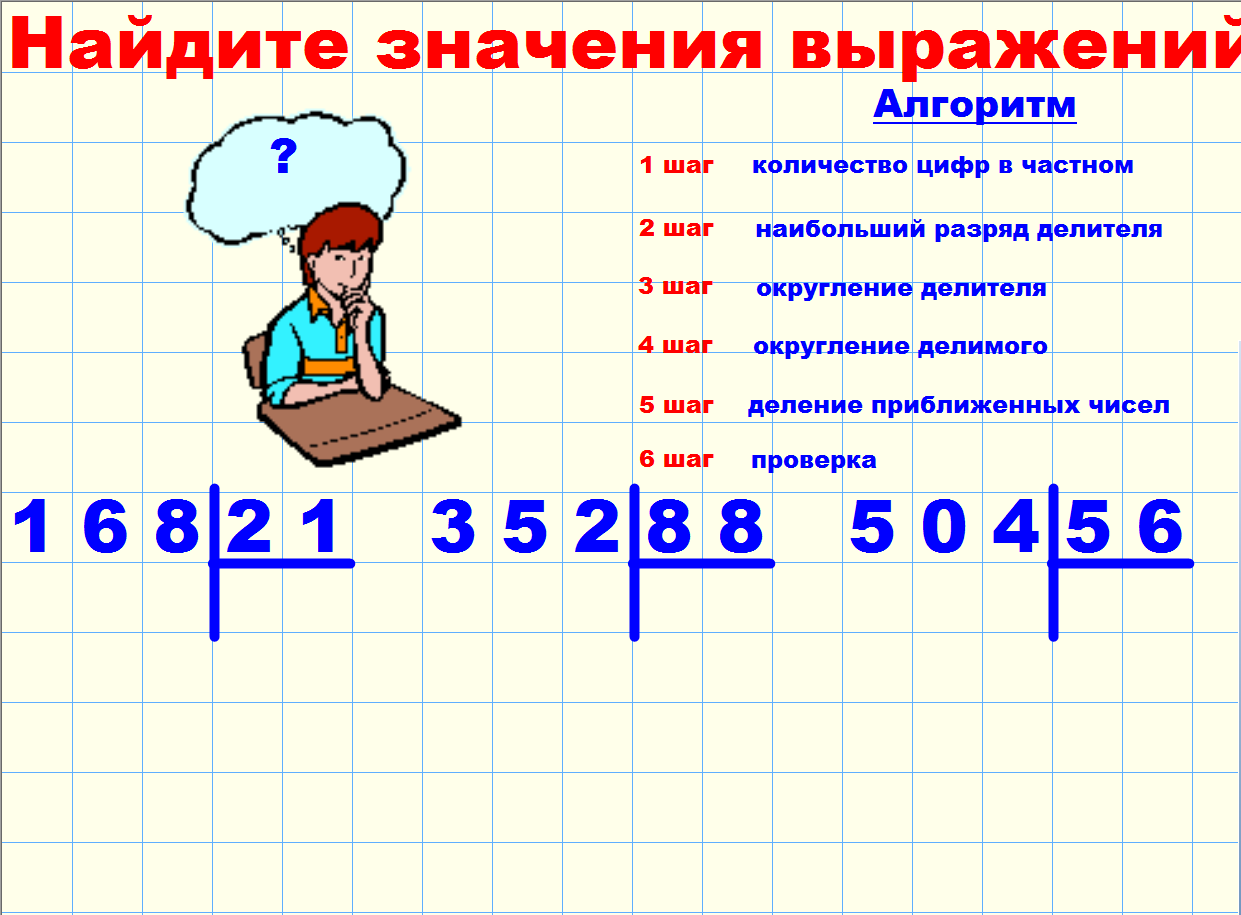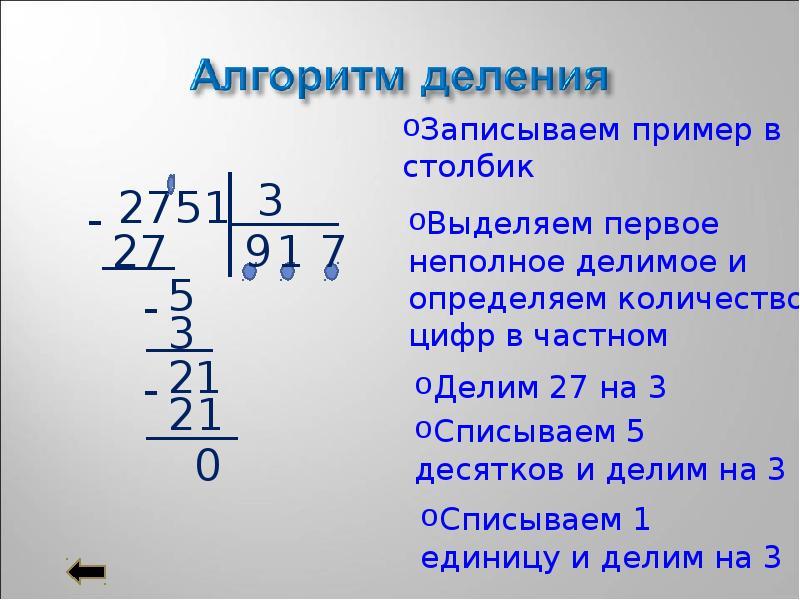To teach a child a column is simple. It is necessary to explain the algorithm of this action and fix the material passed.
Content
- How to explain the child with a column?
- Unambiguous division
- Written division into a two -digit number
- Three -digit
- Division with the remainder
- The algorithm for dividing numbers
- Division games
- Video: game arithmetic for children Addition subtraction division multiplication
- Video: Developing cartoon mathematics study by heart of the multiplication and division table by 2
- Video: acquaintance with division | Funny mathematics for kids
- According to the school curriculum, they begin to explain the column for children already in the third grade. Pupils who capture everything “on the fly” quickly understand this topic
- But, if the child fell ill and missed the lessons of mathematics, or he did not understand the topic, then parents should explain the material on their own. You need to convey information to it as accessible as possible
- Moms and dads during the educational process of the child should be patient, showing a beat in relation to their child. In no case should you scream at the child, if he doesn’t succeed, because this can be repelled from him all the hunt for classes
How to explain the child with a column?

Important: for the child to understand the division of numbers, he must thoroughly know the multiplication table. If the baby does not know multiplication well, he will not understand the division.
During home additional classes, you can use cheat sheets, but the child must learn the multiplication table before proceed to the topic “division”.
So, how to explain to the child the division of the column:
- Try to explain first on small numbers. Take counting sticks, for example, 8 pieces
- Ask the child, how many pairs are in this row of sticks? That's right - 4. So, if you divide 8 by 2, it turns out 4, and when dividing 8 by 4 it turns out 2
- Let the child himself share another number, for example, more complex: 24: 4
- Когда малыш освоил деление простых чисел, тогда можно переходить к делению трехзначных чисел на однозначные
Unambiguous division

Division is always given to children a little more complicated than multiplication. But zealous additional classes at home will help the baby understand the algorithm of this action and do not lag behind peers at school.
Start with a simple one - division into a definite number:
Important: calculate in the mind so that the division turns out without a trace, otherwise the child can get confused.
For example, 256 divide by 4:
- Draw a vertical line on a sheet of paper and divide it from the right side in half. Write the first digit on the left, and the second is above the line
- Ask the baby how many four are placed in a deuce - not at all
- Then we take 25. For clarity, separate this number from above. Again, ask the child, how many four are placed in twenty -five? That's right - six. We write the number "6" in the lower right corner under the line. The child must use the multiplication table for the correct answer
- Write down under 25 digits 24, and emphasize to record the answer - 1
- Ask again: in unit how many four are placed - not at all. Then we demolish the number "6" to the unit
- It turned out 16 - how many four are placed in this number? Correct - 4. Record "4" next to "6" in the response
- We write 16 under 16, we emphasize and it turns out “0”, so we divided correctly and the answer turned out “64”
Written division into a two -digit number

When the child has mastered the division into a definite number, you can move on. A written division into a two -digit number is slightly more complicated, but if the baby understands how this action is performed, then it will not be difficult to solve such examples.
Important: start explaining again with simple actions. The child will learn to choose the right numbers and it will be easy for him to share complex numbers.
Perform such a simple action together: 184: 23 - how to explain:
- We divide first 184 by 20, it turns out about 8. But we do not write the number 8 in response, as this is a trial figure
- We check whether 8 or not. We multiply 8 by 23, it turns out 184 - this is exactly the number that we have in the divider. The answer will be 8
Important: for the child to understand, try to take 9 instead of eight, let him multiply 9 by 23, it turns out 207 - this is more than in our divider. The number 9 is not suitable for us.
So gradually the baby will understand the division, and it will be easy for him to share more complex numbers:
- Divide 768 by 24. Determine the first digit of the private - divide 76 not by 24, but by 20, it turns out 3. Record 3 in response under the line on the right
- At 76, write 72 and draw a line, write down the difference - it turned out 4. Does this figure are divided by 24? No - demolish 8, it turns out 48
- The number 48 is divided into 24? That's right - yes. It turns out 2, write this figure in response
- It turned out 32. Now you can check whether we performed the correct division. Make multiplication into the column: 24x32, it turns out 768, so everything is correct
Three -digit

If the child has learned to be divided into a two -digit number, then it is necessary to move on to the next topic. The division algorithm into a three -digit number is the same as the division algorithm into a two -digit number.
For example:
- We divide 146064 by 716. We first take 146 - ask the child divides this number by 716 or not. That's right - no, then take 1460
- How many times will the number 716 fit among 1460? That's right - 2, so we write this figure in the answer
- Multiply 2 by 716, it turns out 1432. Record this figure under 1460. It turns out the difference 28, write down under the line
- Demolish 6. Ask the child - 286 is divided into 716? That's right - no, so we write 0 in the answer next to 2. We demolish the number 4
- Divide 2864 by 716. We take 3 - not enough, 5 - a lot, so it turns out 4. Multiply 4 by 716, it turns out 2864
- Write down 2864 under 2864, it turns out in a difference of 0. Answer 204
Important: to verify the correctness of the division, multiply with the child into a column - 204x716 \u003d 146064. The division is performed correctly.
Division with the remainder

The time has come to explain to the child that the division can be not only aimed, but also with the remainder. The remainder is always less than the divider or equal to him.
The division with the remainder should be explained on a simple example: 35: 8 \u003d 4 (balance 3):
- How many eights are it in 35? Correct - 4. Remains 3
- Is this figure to be divided by 8? That's right - no. It turns out the rest 3
After that, the child must find out that the division can continue by preparing 0 to number 3:
- The figure is the number 4. After it we write a comma, since the addition of zero suggests that the number will be with a fraction
- It turned out 30. Divide 30 by 8, it turns out 3. Record in response, and at 30 we write 24, we emphasize and write 6
- We demolish the number 6 number 0. Divide 60 by 8. We take 7, it turns out 56. We write under 60 and write down the difference 4
- DECECTIVE 4 DECECTIONS 0 and divide by 8, it turns out 5 - write in response
- We subtract 40 out of 40, it turns out 0. So, answer: 35: 8 \u003d 4,375
The algorithm for dividing numbers

Tip: if the child did not understand something-do not be angry. Let it go a couple of days and try to explain the material again.
Mathematics lessons at school will also consolidate knowledge. Time will pass and the baby will quickly and easily solve any examples for division.
The algorithm for dividing numbers is as follows:
- Make an explicit of the number that will be responsible
- Find the first incomplete division
- Determine the number of numbers in private
- Find the numbers in each category of private
- Find the remainder (if it is)
According to this algorithm, division is performed into unambiguous numbers and any multi -digit number (two -digit, three -digit, four -digit and so on).
Division games

When practicing with a child, more often set examples for him to perform an estate. He should quickly calculate the answer in his mind. For example:
- 1428:42
- 2924:68
- 30296:56
- 136576:64
- 16514:718
To consolidate the result, you can use such division games:
- "Puzzle". Write five examples on a sheet of paper. Only one of them should be with the correct answer.
Condition for a child: among several examples, only one is resolved correctly. Find it in a minute.
Video: game arithmetic for children Addition subtraction division multiplication
Video: Developing cartoon mathematics study by heart of the multiplication and division table by 2
Video: acquaintance with division | Funny mathematics for kids
Video: Division of a two -digit number by unequivocal
When the child is additionally engaged in at home, he fixes the material covered in school. Thanks to this, it is easier for him to study and he will not lag behind his peers. Therefore, help your children, do at home with them. And the baby will succeed!







